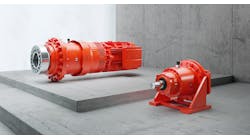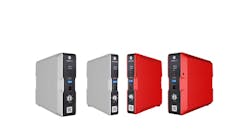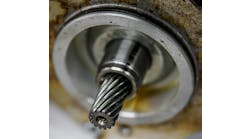Jim Montague is the executive editor for Control, Control Design and Industrial Networking. Email him at [email protected].
Shuttleworth in Huntington, Indiana, knows these needs as well as any machine builder because it was founded by the inventor of Slip-Torque low-back-pressure conveying that's been gently and speedily handling products and packaging for more than 50 years. Jim Shuttleworth started his company in 1962 after selling all but the machinery part of the canning business his father, Charles, started in 1938. The younger Shuttleworth worked in his dad's company from a very young age, and, when he was just 13 years old, they jointly developed a can unscrambler that allowed cans to be fed in before spinning them out one by one.
Read Also: Modular Materials Handling
Shuttleworth later earned a mechanical engineering degree from Purdue University, but his father died when he was 22 years old, and he sold the canning business to Hunt Foods three years later. The new machine firm didn't lose any time and quickly developed its Shuttleworth Futurematic high-speed, hydraulic case packer for placing bottles or cans into cases, and began licensing it internationally in 1965. Over the years, the company grew to accommodate material handling tasks in the automotive, consumer electronics, energy, food, healthcare, industrial and paper industries.
These and other applications have all benefited from the Slip-Torque technology that Shuttleworth developed in the mid-1970s. It uses the coefficient of friction between rotating, stainless steel shafts and loose-fit rollers with many different surfaces to control the driving force transmitted to conveyed products, and it then slips during accumulation to minimize damage on products, such as frozen pie crust shells. Slip-Torque gently accumulates, flips, stacks, rotates, pushes, diverts, indexes, combines and forms products into patterns between manufacturing processes.
"Traditional case packers weren't very good at handling the tops of bottles and would move them and then be unable to find their necks. Slip-Torque was able to accumulate them better for more efficient packing, and then more applications were found on accumulation tables after filling and before lidding," says Todd Eckert, Shuttleworth's business development manager. "This buffer zone allowed fillers to keep working while lidder operations were set up and then meter out products as needed. This provided a lot more flexibility between filling and lidding, but Slip-Torque can do the same between unscrambling and filling or at the beginning or end of a whole production line."
In addition, Slip-Torque's flexible, modular components include multi-lane, multi-speed, multi-pressure capabilities, as well as forward and backward direction in one frame and delivered by one drive. It's also ideal for sensitive material handling requirements, including Class 1 clean rooms; explosive, conductive or chemically sensitive or abusive environments; heavy washdown or blow-off cleaning applications; and production lines affected by powdered metal, paper dust or machining oil.
Though Shuttleworth himself died in 2003, his company and his legacy of innovations continue to serve users worldwide as a leading designer and manufacturer of conveyors for sensitive, fragile and difficult-to-handle items. His wife and longtime marketing director, Carol, ran the firm until 2011, when she retired and sold it to Pro Mach in Loveland, Ohio.
In the past eight years, Shuttleworth's professional heirs have added new innovations and capabilities to the company's machines, including speed modulation; high-speed, gated in-feeds; servo motors and servo drives; and better sensors, including vision. During the same period, the company developed and launched its first standard, high-speed, gated in-feed machine, SmartFeed, which stages products coming in randomly, stops them briefly at a gate, uses a presence sensor to check each flight of products, and then times their release. SmartFeed previously used a 1-hp motor and belt drive, but now uses a 1/4-hp motor and chain drive, which can run up to an 80-ft conveyor frame section to better avoid product separations and gaps. The machine builder typically employs MicroLogix 1000 or 1400 PLCs, Allen-Bradley PowerFlex 4 variable-frequency drives (VFDs) and EtherNet/IP networking components from Rockwell Automation.
"This is a lot easier than traditional belt conveyors because they need multiple frames and drives, but SmartFeed only requires one frame for multiple drives," explains Eckert. "The speed modulation and sensing we've added in the last eight or nine years allow us to run different lengths of the same conveyor at different speeds, which means we can tell a wrapping machine on the line to speed up or slow down, and better match other materials to their production operations. We've been using fractional-horsepower motors, such as Brother or Dodge, for about 15 years, but we only added vision systems about four or five years ago. We can integrate Cognex, Banner, Dalsa for barcode reading, color sensing or whatever other functions our customers need to perform."
Likewise, Eckert reports that product stops in Shuttleworth's high-speed, gated in-feed equipment have transitioned over the years from all pneumatic controls to also offering servo-driven rotary actuators, such as those available from Rockwell Automation or Parker Hannifin, which allow more speed, accuracy and better placement of products. "For example, if we're running at 80 ft/min, we can begin with low-back-pressure accumulating and speed-modulated conveying, better manage the end-to-end section in the middle and match the film speed of a wrapper on the end section," says Eckert. "We also have a lot more choices with our family of solutions. A line running at 60 ft/min to a wrapper can still use pneumatic gates; a line running at 100 ft/min can use a servo-rotary gate; and a line running at 200 ft/min can use servo motors and drives, SmartFeed and servo-based correction zones."
This level of flexibility is another tradition at Shuttleworth because, even though SmartFeed is a standard family of automated, in-feed solutions, almost all of the company's material handling equipment and projects are still custom-designed and built for each user's application. "We do industrial designs based on aluminum frames and use stainless steel and food-grade rollers in wipe-down and washdown applications. In fact, we can install 60 different types of rollers based on the requirements of each application," adds Eckert. "As always, we just match the right technology to the speed and capabilities required by each customer and make sure it will deliver the best performance and return in investment for them."




